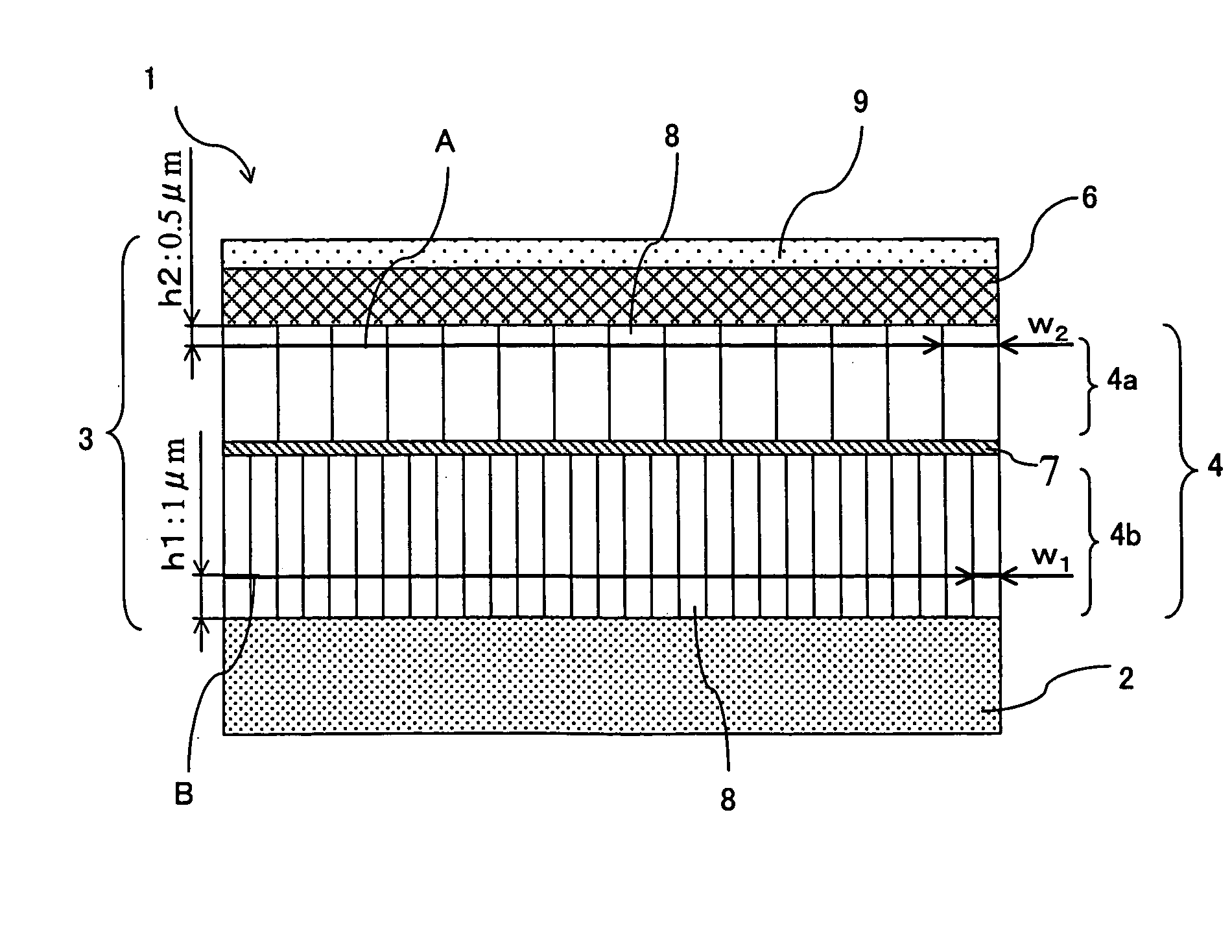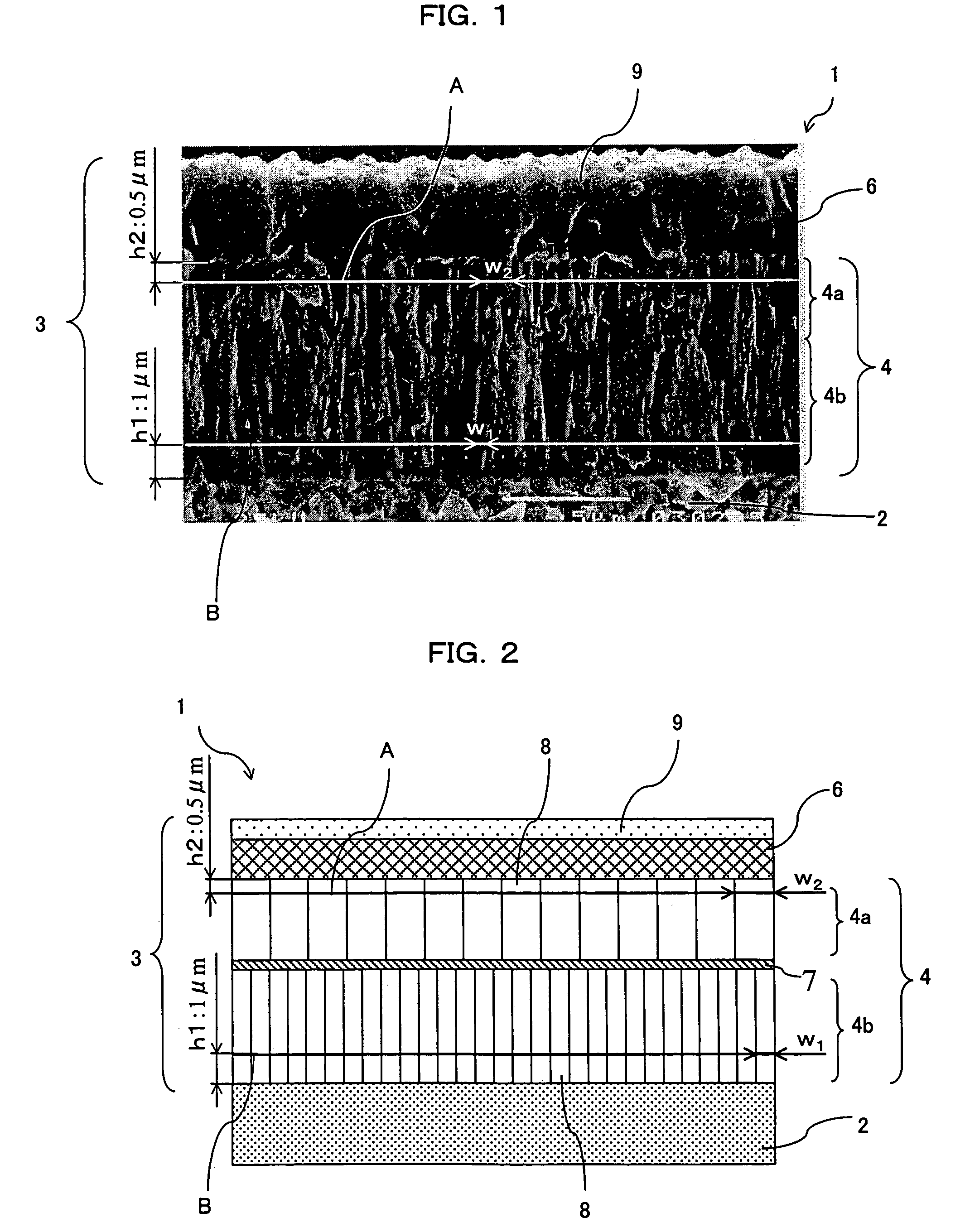Surface-coated member
a surface coating and member technology, applied in the field of surface coating members, can solve the problems of affecting the cutting speed of the cutting tool, and the rake surface or peeling of the hard coating layer, etc., and achieves the effects of high feed rate cutting, excellent breakage resistance, and high wear resistan
- Summary
- Abstract
- Description
- Claims
- Application Information
AI Technical Summary
Benefits of technology
Problems solved by technology
Method used
Image
Examples
embodiment 1
[0052]An example of the cutting tool which is a preferred embodiment of the surface-coated member of the present invention will be described below with reference to FIG. 1 which is a photograph taken with a scanning electron microscope (SEM) showing a fracture surface including the hard coating layer and FIG. 2 which schematically shows the same.
[0053]In FIG. 1, the surface-coated cutting tool (hereinafter referred to simply as the cutting tool) 1 comprises a base body 2 and a hard coating layer 3 formed thereon. The base body 2 may be made of, for example, (i) cemented carbide consisting of carbonitride phase made of tungsten carbide (WC) and at least one kind selected from among a group of carbide, nitride and carbonitride of metals of the groups 4a, 5a and 6a of the Periodic Table that is held together by a binder phase consisting of an iron group metal such as cobalt (Co) and / or nickel (Ni); or (ii) a hard alloy such as cermet consisting mainly of titanium carbide (TiC) or titan...
embodiment 2
[0079]This embodiment is to obtain the cutting tool 1 by coating the surface of the base body 2 with the hard coating layer 3 similarly to the above embodiment. The hard coating layer 3 consists of at least the titanium carbonitride (TiCN) layer and the alumina (Al2O3) layer formed successively on the surface of the base body 2, while the TiCN layer is formed from stringer-like TiCN crystal that is grown in a direction perpendicular to the interface with the base body and is constituted from at least two layers having different ratios C / N of proportions of carbon C and nitrogen N, namely a carbon-rich TiCN layer where C / N ratio is in a range of 1.5≦C / N≦4 located at the top on the Al2O3 layer 3 side, and a nitrogen-rich TiCN layer located below the carbon-rich TiCN layer where the ratio C / N is in a range of 0.2≦C / N≦0.7.
[0080]The ratio C / N of carbon C and nitrogen N in the TiCN layer is measured on a fracture surface of the coating film or a surface obtained by polishing the fracture ...
embodiment 3
[0096]The cutting tool of this embodiment will be described below with reference to FIG. 3 through FIG. 6. In FIG. 3, the cutting tool of the present invention comprises a base body 16 made of tungsten carbide-based cemented carbide and a hard coating film 11 formed so as to coat the surface of the base body by successively forming a Ti-based layer (first layer) containing the TiCN layer 12 mentioned above and an Al2O3 layer 14 (third layer).
[0097]A binding layer 13 (second layer) that includes at least titanium (Ti), aluminum (Al), tungsten (W) and cobalt (Co) is interposed between the Ti-based layer containing the TiCN layer 12 and the Al2O3 layer 14. The binding layer 13 serves the role of the intermediate layer to increase the adhesion force between the TiCN layer 12 and the Al2O3 layer 14, increase the adhesion force of the hard coating layer 1 and suppress the cutting performance such as chipping resistance, film peel-off resistance and wear resistance from decreasing during c...
PUM
| Property | Measurement | Unit |
|---|---|---|
| crystal width | aaaaa | aaaaa |
| thickness | aaaaa | aaaaa |
| adhesion force | aaaaa | aaaaa |
Abstract
Description
Claims
Application Information
 Login to View More
Login to View More - R&D
- Intellectual Property
- Life Sciences
- Materials
- Tech Scout
- Unparalleled Data Quality
- Higher Quality Content
- 60% Fewer Hallucinations
Browse by: Latest US Patents, China's latest patents, Technical Efficacy Thesaurus, Application Domain, Technology Topic, Popular Technical Reports.
© 2025 PatSnap. All rights reserved.Legal|Privacy policy|Modern Slavery Act Transparency Statement|Sitemap|About US| Contact US: help@patsnap.com



